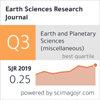基于GIS遥感的旅游景区水源地重金属污染溯源
IF 0.7
4区 地球科学
Q4 GEOSCIENCES, MULTIDISCIPLINARY
引用次数: 2
摘要
为了有效预防旅游景区水源地重金属污染,明确重金属污染源的控制程度,提高追踪结果的准确性,提出了一种基于GIS的旅游景区重金属污染遥感方法。利用GIS空间分析方法,获取遥感监测的DEM高程数据,编制流域地理信息,GPS获取经纬度坐标,定位重金属污染源。设计了插件应用框架,并将流域地理信息和插件应用框架相结合,构建了污染追踪平台。根据污染物进入水源后的混合方向,建立了重金属污染在水源中的迁移扩散坐标系。通过重金属污染物在水源地的迁移、转化和浓度,构建了水源地重金属污染物的时空分布函数模型。得出了风景名胜区水源地重金属污染的溯源结果。结果表明,重金属污染元素的变异系数依次为Cr>Cd>Cu>Ni>Zn>Pb。重金属污染元素的空间分布极不均匀。Ni和Cr之间存在一定的正相关,Cu和Zn的相关系数为0.78。正相关非常显著,同源性非常强。此外,该方法的识别结果与实际值非常接近,能够准确地对旅游景区水源地重金属污染源进行溯源,溯源误差小,溯源结果评价精度高。本文章由计算机程序翻译,如有差异,请以英文原文为准。
Tracing the source of heavy metal pollution in water sources of Tourist Attractions Based on GIS remote sensing
To effectively prevent heavy metal pollution in water sources in tourist attractions, clarify the degree of control of heavy metal pollution sources, and improve the accuracy of tracing results, a GIS-based remote sensing method of heavy metal pollution in tourist attractions is proposed. Using GIS spatial analysis method, the DEM elevation data monitored by remote sensing is obtained, the watershed geographic information is compiled, and the GPS obtains the longitude and latitude coordinates to locate the source of heavy metal pollution. The plug-in application framework is designed, and the watershed geographic information and plug-in application framework are integrated to build the pollution tracing platform. According to the mixing direction of pollutants after entering the water source, the migration and diffusion coordinate system of heavy metal pollution in the water source is established. The spatial-temporal distribution function model of heavy metal pollutants in water sources is constructed through the migration, transformation, and concentration of heavy metal pollutants in water sources. The tracing results of heavy metal pollution in water sources of scenic spots are obtained. The results showed that the order of variation coefficient of heavy metal pollution elements was Cr > Cd > Cu > Ni > Zn > Pb. The spatial distribution of heavy metal pollution elements was extremely uneven. There was a certain positive correlation between Ni and Cr, and the correlation coefficient of Cu and Zn was 0.78. The positive correlation was very significant, and the homology was very strong. Moreover, the identification result of the proposed method is very close to the real value, which can accurately trace the source of heavy metal pollution in the water source of tourist attractions, with small tracing error and high accuracy of tracing result evaluation.
求助全文
通过发布文献求助,成功后即可免费获取论文全文。
去求助
来源期刊

Earth Sciences Research Journal
地学-地球科学综合
CiteScore
1.50
自引率
0.00%
发文量
0
审稿时长
>12 weeks
期刊介绍:
ESRJ publishes the results from technical and scientific research on various disciplines of Earth Sciences and its interactions with several engineering applications.
Works will only be considered if not previously published anywhere else. Manuscripts must contain information derived from scientific research projects or technical developments. The ideas expressed by publishing in ESRJ are the sole responsibility of the authors.
We gladly consider manuscripts in the following subject areas:
-Geophysics: Seismology, Seismic Prospecting, Gravimetric, Magnetic and Electrical methods.
-Geology: Volcanology, Tectonics, Neotectonics, Geomorphology, Geochemistry, Geothermal Energy, ---Glaciology, Ore Geology, Environmental Geology, Geological Hazards.
-Geodesy: Geodynamics, GPS measurements applied to geological and geophysical problems.
-Basic Sciences and Computer Science applied to Geology and Geophysics.
-Meteorology and Atmospheric Sciences.
-Oceanography.
-Planetary Sciences.
-Engineering: Earthquake Engineering and Seismology Engineering, Geological Engineering, Geotechnics.
 求助内容:
求助内容: 应助结果提醒方式:
应助结果提醒方式:


